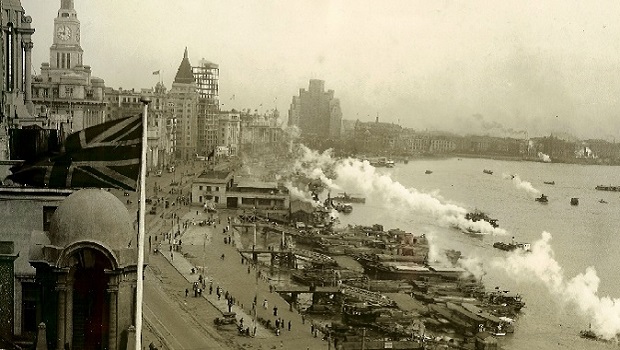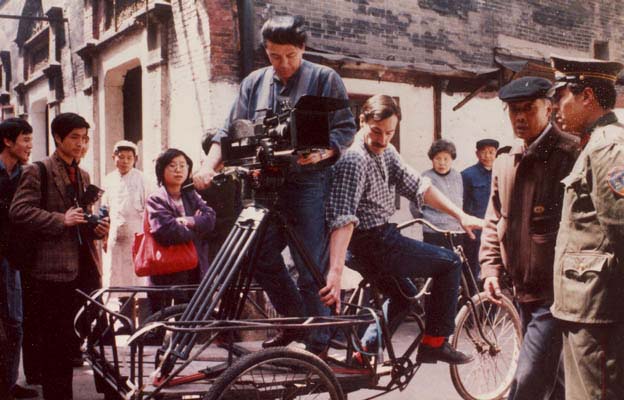(Les Films de la Mémoire)
Documentary / 95′ / 1990

Escape to the Rising Sun documents the experience of 20.000 Jews who fled Nazi persecutions in Europe and took refuge in Shanghai, China, during World War II. For several thousands of them, escape meant travelling through the Soviet Union and Japan before eventually reaching Shanghai.
Throughout the Japanese occupation the refugees were completely cut off from the outside world.
After the liberation, they began leaving for new homes in Europe, the United States, Israel and Australia.
Belgium DOC

AKA Survivre à Shanghai
In 1939, Jews lucky enough to escape the Nazis’ reach in Europe had only one place in the world to go that didn’t require an exit visa: Shanghai. Escape to the Rising Sun tells the little-known and ironic story of nearly 5,000 Jews who reached Shanghai through the USSR with the help of the Japanese Consul in Lithuania and the Kobe (Japan) Jewish Committee. In the slums of Hongkew, they lived in extreme poverty, battling disease and malnutrition; still, they worked to reconstruct elements of their culture, organizing literary, artistic, and educational programs.
After the Japanese occupation of Shanghai, conditions worsened until German pressure forced the issue of a proclamation ordering all refugees into a ghetto covering an area less than one square mile, where they remained until Shanghai was liberated by the Americans at the end of the war. This documentary features rare footage of the former ghetto of Hongkew, archival material, as well as first-hand accounts from eyewitnesses. Nearly seventy survivors of this amazing escape were interviewed, and fifteen of them were chosen to reveal their story.
The National Center for Jewish Film & IMDb
Prize of the City of Strasbourg & Prize of the Universities : 19th Film Festival of Strasbourg – Institut International des Droits de l’Homme, France – 1991

“… One of cinema’s finer achievements – a rare glimpse of compassion, courage and survival.”
– Sunday Herald Sun
“In Escape to the Rising Sun , Belgian filmmaker Diane Perelsztejn has added an authoritative visual essay to the small body of work on the mid-century Shanghai Jews…”
– Peter Kohn, Australian Jewish News
Regie Diane Perelsztejn
Filmmontage Ewald Wels

Niet lang na uitzending op televisie van de documentaire over Anne Frank werd ik door Diane Perelsztejn gevraagd om haar documentaire over Joodse vluchtelingen tijdens WOII te monteren. Het was een bijzonder verhaal waarvoor zij de hele wereld afreisde. Tijdens de montage werd overal nog materiaal opgenomen en verzameld. Samen met Diane reisde ik naar filmarchieven in Engeland en Duitsland en ging ik mee naar onderhandelingsgesprekken met de directeur van het ZDF. Zij gaf mij een grote inbreng, niet alleen tijdens de montage, maar ook tijdens nasynchronisatie in verschillende talen en bij de opnames voor de muziek. Het eindresultaat is een boeiende historische documentaire geworden, die een positief verhaal vertelt uit de Joodse holocaustgeschiedenis. De documentaire is in veel landen op televisie uitgezonden, waaronder Duitsland en Japan.
Een bijzonder en soms vervelend aspect van het werken aan een succesvolle productie is de wens van anderen om dit succes te kopiëren. De film over Anne Frank werd binnen een paar jaar door een andere regisseur vrijwel letterlijk nagemaakt in het Engels en won vervolgens een Oscar. ‘Escape to the Rising Sun’ trof een zelfde lot in overtreffende trap. De film is meerdere malen nagemaakt, deels gekopieerd. Non-fictie boeken werden geschreven en zelfs een vuistdikke roman verscheen. Allen met (bijna) hetzelfde verhaal. Zie onderstaand artikel.
REMEMBERING THE GHETTO- MOVIES
One of the most potent triggers of interest outside china has been a stream of films made about Shanghai. Often prompted by survivors, the films contributed to one of the central themes of Chinese cosmopolitanism that only in China were Jews received, accepted, and saved. In China anti-Semitism did not exist. In China the stranger was welcomed and protected.
It was not then so much that the Jews were a funnel of cosmopolitan modernity into China , but that China was already cosmopolitan ab initio, and therefore able to recognize a common humanity beyond the labels of European ideologies.The first of these films –Escape to the Rising Sun, shot in April 1989- documented the return to Shanghai by fifteen survivors from Europe, retracing their steps. Most of the other films followed similar paths. The films’ titles build a narrative -A Place to Save Your Life (1992), Exile Shanghai (1997), Port of Last Resort (1998 ), Fleeing to Shanghai (2000), and Shanghai Ghetto (2002). Fleeing to Shanghai, made by Shanghai Television, was produced in Chinese and English versions, and shown on Shanghai television, thereby introducing this history and the themes of their cosmopolitan humanitarianism to the local population.
